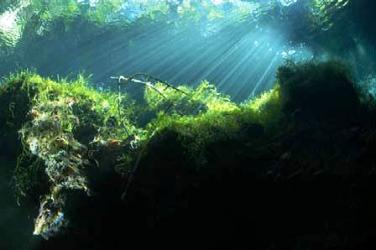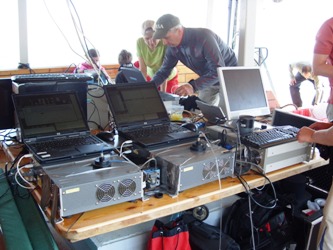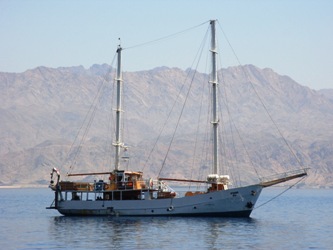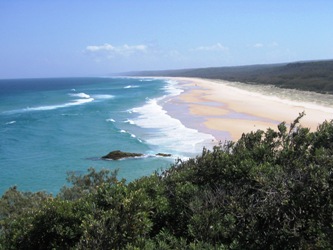Studies Around the Globe
In the last decade, members of the phytoplankton dynamics lab have participated in projects which have taken them around the globe. Below are some examples.
Projects
Qatar peninsula, Arabian Gulf
Phytoplankton dynamics along the coastal shelf of an oligotrophic hypersaline environment in a semi-enclosed marginal sea

Phytoplankton biomass (chlorophyll a concentration), primary production, abundance, species diversity and species groupings were measured in the coastal waters surrounding Qatar (Arabian Gulf) at thirteen stations in February 2010, July 2010, February 2011 and May 2011. In addition, a broad suite of physico-chemical characteristics were measured: temperature, salinity, pH, dissolved oxygen, turbidity, and nutrients (dissolved and particulate). Waters surrounding the Qatari peninsula were found to be highly diverse (125 species of diatoms, dinoflagellates and cyanobacteria were identified) but were low in both biomass (0.18-2.19 μg Chl a l-1) and productivity (0.14-0.97 mg C m-2 day-1). Phytoplankton physiology (Fv/Fm, sPSII, tQa, p) revealed acclimation strategies consistent with phytoplankton populations receiving ample light but insufficient nutrients. The finding of low primary production was consistent with water column nutrient ratios (DIN:P and DIN:Si ratios < 1) and by nutrient enrichment experiments in which the addition of nitrate or the addition of near-bottom waters stimulated biomass production of phytoplankton. This study in an oligotrophic, hypersaline semi-enclosed marginal sea is intended to contribute to the growing body of ecological information on how such seemingly stressed ecosystems function. Further, it compliments companion assessments made of grazing zooplankton and benthic invertebrates, which together will be used to develop food web models.
Quigg, A., Al-Anasi, M., Nour Al Din, N., Wei,C-L., Nunnally, C.C., Al-Ansari, I.S., Rowe, G., Soliman, Y., Al-Maslamani, I., Mahmoud, I., Youseff, N. and Abdel Moati, M.A. 2013 Phytoplankton along the coastal shelf of an oligotrophic hypersaline environment in a semi-enclosed marginal sea: Qatar (Arabian Gulf). Continental Shelf Research. 60: 1-16.
Wei,C-L., Rowe, G., Al-Anasi, M., Al-Maslamani, I., Soliman, Y., Nour Al Din, N., Al-Ansari, I.S., Al-Shaikh, I., Quigg, A., Nunnally, C.C., and Abdel Moati, M.A. 2016 Macrobenthos in the Central Arabian Gulf: a Reflection of Climate Extremes and Variability. Hydrobiologia. DOI 10.1007/s10750-015-2568-7
Bermuda
Effect of nutrient enrichment on naturally occurring algal species in six cave pools of Bermuda

Bermuda has one of the highest concentrations of cave systems of any country in the world. As the island’s resident human population and tourism expand, its unique subterranean habitats are becoming increasingly threatened by development and eutrophication. The response to nutrient enrichment of six macroalgal species found in Bermuda’s anchialine cave pools (landlocked body with a subterranean connection to the ocean) was examined during summer of 2007. We used a combination of nutrient bioassays, productivity measurements, and water quality analysis. Ulva sp. (Chlorophyta) responded similarly across all nutrient treatments (+N as 30 mMnitrate, +P as 2 mMphosphate, and +NP as 30 mM nitrate + 2 mM phosphate) at Calabash, which had dissolved inorganic N (DIN):soluble reactive P (SRP) ratios of 13–16, whereas at Harbour Pool, Ulva sp. responded best to the +N addition alone. The latter was consistent with very low DIN:SRP (5.8) ratios indicative of potential N limitation in this pool. P limitation was only detected in nutrient assays conducted with Caulerpa mexicana (Chlorophyta) collected from Cliff Pool, which had DIN:SRP ratios of 110. Halymenia floresia (Rhodophyta) was found to be light rather than nutrient limited in the Emerald cave pool. In some combinations of cave pools (e.g. Grenadier and Deep Blue) and for some macroalgae [e.g. Caulerpa racemosa (Chlorophyta), Caulerpia sertularioides (Chlorophyta), and Cryptonemia sp. (Rhodophyta)], findings were not easily characterized with measured parameters. Our findings illustrate the importance of evaluating individual cave pools as well as individual macroalgal species in each cave pool. Of the six macroalgae examined, Ulva sp. and H. floresia showed the greatest potential as bioindicators for groundwater quality in Bermudian caves.
Maloney, B., Iliffe, T. M., Gelwick, F. and Quigg, A. 2011. Effect of nutrient enrichment on naturally occurring algal species in six cave pools of Bermuda. Phycologia. 50: 132-143
Gulf of Aqaba, Eilat, Israel
As part of the 8th Group for Aquatic Primary Productivity International Workshop, Eilat, Israel held on the 30 March and 8 April, 2008, we participated in a side-by-side comparison of the state-of-the-art fluorometers for assessing phytoplankton activity. Given the oligotrophic nature of the Gulf of Aqaba, we examined nutrient controls of microbial growth.
Gross and Net Primary Production: Closing the Gap between Concepts and Measurements

We are living at a time when accurate knowledge of the magnitude of the drawdown of inorganic carbon by autotrophic metabolism is especially crucial to our understanding of global carbon cycling and the functioning of the global ecosystem. Since algae contribute approximately half of the planet’s annual primary productivity, understanding the processes contributing to the net assimilation of CO2 is critical. In this paper, we briefly discuss the range of approaches to measurements of aquatic photosynthesis that have been used, including more recent developments such as fluorescence and stable isotope studies, and whether these provide data that reflect net or gross productivity. We then consider the range of processes that run counter to photosynthetic carbon assimilation, with emphasis on respiration (and its measurement) and excretion of dissolved organic carbon, and how these affect our estimates of net primary production. We conclude by briefly assessing how future changes in global climate might impact not just overall primary productivity, but also the balance between net and gross carbon assimilation.
Beardall, J., Ihnken, S. and Quigg, A. 2009. Gross and Net Primary Production: Closing the Gap between Concepts and Measurements. Aquatic Microbial Ecology. 56: 227-239.
Nutrient control of oceanic microbial growth during spring in the Gulf of Aqaba
 Bioassay experiments were performed to identify how growth of key groups within the microbial community was simultaneously limited by nutrient (nitrogen and phosphorus) availability during spring in the Gulf of Aqaba’s oceanic waters. Measurements of chlorophyll a (chl a) concentration and fast repetition rate (FRR) fluorescence generally demonstrated that growth of obligate phototrophic phytoplankton was co-limited by N and P and growth of facultative aerobic anoxygenic photoheterotropic (AAP) bacteria was limited by N. Phytoplankton exhibited an increase in chl a biomass over 24 to 48 h upon relief of nutrient limitation. This response coincided with an increase in photosystem II (PSII) photochemical efficiency (Fv/Fm), but was preceded (within 24 h) by a decrease in effective absorption cross-section (σPSII) and electron turnover time (τ). A similar response for τ and bacterio-chl a was observed for the AAPs. Consistent with the up-regulation of PSII activity with FRR fluorescence were observations of newly synthesized PSII reaction centers via low temperature (77K) fluorescence spectroscopy for addition of N (and N + P). Flow cytometry revealed that the chl a and thus FRR fluorescence responses were partly driven by the picophytoplankton (<10 μm) community, and in particular Synechococcus. Productivity of obligate heterotrophic bacteria exhibited the greatest increase in response to a natural (deep water) treatment, but only a small increase in response to N and P addition, demonstrating the importance of additional substrates (most likely dissolved organic carbon) in moderating the heterotrophs. These data support previous observations that the microbial community response (autotrophy relative to heterotrophy) is critically dependent upon the nature of transient nutrient enrichment.
Bioassay experiments were performed to identify how growth of key groups within the microbial community was simultaneously limited by nutrient (nitrogen and phosphorus) availability during spring in the Gulf of Aqaba’s oceanic waters. Measurements of chlorophyll a (chl a) concentration and fast repetition rate (FRR) fluorescence generally demonstrated that growth of obligate phototrophic phytoplankton was co-limited by N and P and growth of facultative aerobic anoxygenic photoheterotropic (AAP) bacteria was limited by N. Phytoplankton exhibited an increase in chl a biomass over 24 to 48 h upon relief of nutrient limitation. This response coincided with an increase in photosystem II (PSII) photochemical efficiency (Fv/Fm), but was preceded (within 24 h) by a decrease in effective absorption cross-section (σPSII) and electron turnover time (τ). A similar response for τ and bacterio-chl a was observed for the AAPs. Consistent with the up-regulation of PSII activity with FRR fluorescence were observations of newly synthesized PSII reaction centers via low temperature (77K) fluorescence spectroscopy for addition of N (and N + P). Flow cytometry revealed that the chl a and thus FRR fluorescence responses were partly driven by the picophytoplankton (<10 μm) community, and in particular Synechococcus. Productivity of obligate heterotrophic bacteria exhibited the greatest increase in response to a natural (deep water) treatment, but only a small increase in response to N and P addition, demonstrating the importance of additional substrates (most likely dissolved organic carbon) in moderating the heterotrophs. These data support previous observations that the microbial community response (autotrophy relative to heterotrophy) is critically dependent upon the nature of transient nutrient enrichment.
Suggett, D. J., Stambler, N. Prášil, O., Kolber, Z., Quigg, A., Vázquez-Domínguez, E., Zohary, T., Berman, T., Iluz, D., Levitan, O., Lawson, T., Meeder, E., Lazar, B., Bar-Zeev, E., Medova, H. & Berman-Frank, I. 2009. Nutrient control of oceanic microbial growth during spring in the Gulf of Aqaba. Aquatic Microbial Ecology. 56: 227-239.
Moreton Bay, Queensland, Australia
As part of the Thirteenth International Marine Biological Workshop, The Marine Fauna and Flora of Moreton Bay, Queensland, Australia held on the 7–25 February 2005, we participated in two studies which focused on the flora of this ecoregion. Two papers have been published in the workshop proceedings:
Ecophysiological status of nine species of macroalgae and seagrasses in Moreton Bay, Queensland, Australia

Macroalgae and seagrasses from subtropical Moreton Bay on the east Australian coast were measured in situ using a submersible pulse-amplitude modulated fluorometer (Diving-PAM). The measurements from these marine phototrophs growing in the relatively pristine waters of eastern Moreton Bay will provide useful baseline information for future comparable studies assessing anthropogenic-induced environmental stresses, like those that now exist in the western part of the Bay. Importantly, this study redresses the paucity of knowledge on macroalgae that currently exists in this region. The use of this chlorophyll fluorescence technique was attractive because of its non-invasive, quantitative approach providing information on photosynthetic performance of both macroalgae and seagrasses without the need for transplanting or enclosures.
Quigg, A., Kevekordes, K. & Phillips, J.A. 2008. Ecophysiological status of nine species of macroalgae and seagrasses in Moreton Bay, Queensland, Australia. Eds Peter J.F. Davie and Julie A. Phillips. In, Proceedings of the Thirteenth International Marine Biological Workshop, The Marine Fauna and Flora of Moreton Bay, Queensland. Memoirs of the Queensland Museum - Nature. 54: 391-403. Brisbane, Australia.
Phytoplankton productivity across Moreton Bay, Australia: the impact of water quality, light and nutrients on spatial patterns
 Phytoplankton productivity and the factors that regulate it were studied across Moreton Bay (27ºS, 153ºE), a large embayment on the subtropical East Australian coast. Depth profiles of salinity, temperature, pH, turbidity and dissolved oxygen were measured at 73 sites across the Bay. Our measurements showed a general landward to seaward trend in salinity, turbidity and dissolved oxygen profiles, so we have used a representative 20 km transect extending from the mouth of the Brisbane River to the Moreton Bay Research Station at Dunwich on North Stradbroke Island to present our findings. Phyto plankton pigment concentrations were measured at all 73 sites and were generally highest in areas with lower water clarity (Secchi depths < 3.25 m), suggesting nutrients (often associated with turbid waters) rather than light may be determining phytoplankton distributions in Moreton Bay. Based on traditional light/dark bottle experiments undertaken on samples collected at fourteen sites, the Bay was found to be net autotrophic with primary production rates ranging between 0.16 to 3.90 g C m-2 day-1. Resource limitation (also known as nutrient addition) assays, undertaken on samples collected at seven sites in the Bay, indicated that phytoplankton productivity was generally limited by nitrogen (N) sources except at Dohles Rocks in the Pine River mouth where silicate was co-limiting with N. Light limited primary production in the lower reaches of the Brisbane River. Phosphate additions had no impact on phytoplankton productivity. Phytoplankton community composition (ratios of the major groups) did not change over the 48 hour incubation period in the resource limitation assays suggesting either the different components of the community had insufficient time to respond or all components responded similarly. Findings from both the resource limitation assays and the bay-wide phytoplankton pigment survey suggest that nitrogen was the major limiting factor of phytoplankton productivity in Moreton Bay in the summer of this study.
Phytoplankton productivity and the factors that regulate it were studied across Moreton Bay (27ºS, 153ºE), a large embayment on the subtropical East Australian coast. Depth profiles of salinity, temperature, pH, turbidity and dissolved oxygen were measured at 73 sites across the Bay. Our measurements showed a general landward to seaward trend in salinity, turbidity and dissolved oxygen profiles, so we have used a representative 20 km transect extending from the mouth of the Brisbane River to the Moreton Bay Research Station at Dunwich on North Stradbroke Island to present our findings. Phyto plankton pigment concentrations were measured at all 73 sites and were generally highest in areas with lower water clarity (Secchi depths < 3.25 m), suggesting nutrients (often associated with turbid waters) rather than light may be determining phytoplankton distributions in Moreton Bay. Based on traditional light/dark bottle experiments undertaken on samples collected at fourteen sites, the Bay was found to be net autotrophic with primary production rates ranging between 0.16 to 3.90 g C m-2 day-1. Resource limitation (also known as nutrient addition) assays, undertaken on samples collected at seven sites in the Bay, indicated that phytoplankton productivity was generally limited by nitrogen (N) sources except at Dohles Rocks in the Pine River mouth where silicate was co-limiting with N. Light limited primary production in the lower reaches of the Brisbane River. Phosphate additions had no impact on phytoplankton productivity. Phytoplankton community composition (ratios of the major groups) did not change over the 48 hour incubation period in the resource limitation assays suggesting either the different components of the community had insufficient time to respond or all components responded similarly. Findings from both the resource limitation assays and the bay-wide phytoplankton pigment survey suggest that nitrogen was the major limiting factor of phytoplankton productivity in Moreton Bay in the summer of this study.
Quigg, A., Litherland, S., Phillips, J.A., & Kevekordes, K. 2010. Phytoplankton productivity across Moreton Bay, Australia: the impact of water quality, light and nutrients on spatial patterns. In, Proceedings of the Thirteenth International Marine Biological Workshop, The Marine Fauna and Flora of Moreton Bay, Queensland. Memoirs of the Queensland Museum — Nature. 54 (3): 355-372. Brisbane, Australia.